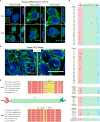Keratins Are Going Nuclear
- PMID: 27505414
- PMCID: PMC5511689
- DOI: 10.1016/j.devcel.2016.07.022
Keratins Are Going Nuclear
Abstract
Previously thought to reside exclusively in the cytoplasm, the cytoskeletal protein keratin 17 (K17) has been recently identified inside the nucleus of tumor epithelial cells with a direct impact on cell proliferation and gene expression. We comment on fundamental questions raised by this new finding and the associated significance.
Copyright © 2016 Elsevier Inc. All rights reserved.
Figures


References
-
- Aebi U, Cohn J, Buhle L, Gerace L. The nuclear lamina is a meshwork of intermediate-type filaments. Nature. 1986;323:560–564. - PubMed
-
- Akoumianaki T, Kardassis D, Polioudaki H, Georgatos SD, Theodoropoulos PA. Nucleocytoplasmic shuttling of soluble tubulin in mammalian cells. J. Cell Sci. 2009;122:1111–1118. - PubMed
-
- Badock V, Steinhusen U, Bommert K, Wittmann-Liebold B, Otto A. Apoptosis-induced cleavage of keratin 15 and keratin 17 in a human breast epithelial cell line. Cell Death Differ. 2001;8:308–315. - PubMed
-
- Bastos R, Engel P, Pujades C, Falchetto R, Aligué R, Bachs O. Increase of cytokeratin D during liver regeneration: association with the nuclear matrix. Hepatology. 1992;16:1434–1446. - PubMed
Publication types
MeSH terms
Substances
Grants and funding
LinkOut - more resources
Full Text Sources
Other Literature Sources
Molecular Biology Databases

